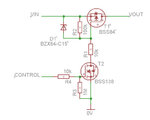louarnold
Member level 2
I have a 24vdc battery supply. A manual switch now provides 22v to a signal wire (using only milliamps) I need to change this to have a micro-controller do the switching. It runs at 5v taking its power from the 24vdc via a 7805 regulator.
I have chosen an optocoupler to switch the 24 v on and and off to the signal wire. Will this work, or is there a better approach?
I have chosen an optocoupler to switch the 24 v on and and off to the signal wire. Will this work, or is there a better approach?


